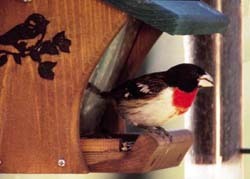Fun Facts About Rose Breasted Grosbeaks
- Bursting with black, white, and rose-red, male Rose-breasted Grosbeaks are like an exclamation mark at your bird feeder or in your binoculars. Females and immatures are streaked brown and white with a bold face pattern and enormous bill. Look for these birds in forest edges and woodlands. Listen, too, for their distinctive voices. They sound like American Robins, but listen for an extra sweetness, as if the bird had operatic training; they also make a sharp chink like the squeak of a sneaker.
- Rose-breasted Grosbeaks breed in moist deciduous forests, deciduous-coniferous forests, thickets, and semi open habitats across the northeastern United States, ranging into southeastern and central Canada. They gravitate toward second-growth woods, suburban areas, parks, gardens, and orchards, as well as shrubby forest edges next to streams, ponds, marshes, roads, or pastures.
- During migration, grosbeaks stop in a wide variety of habitats including primary and secondary forest, wet and dry forest, shrub thickets, pine woods, shrubby dune ridges, scrub, urban areas, and wetlands. They spend the winter in forests and semi open habitats in Central and South America, often in middle elevations and highlands (up to about 11,000 feet in Colombia).
- During the breeding season Rose-breasted Grosbeaks eat a lot of insects, as well as wild fruit and seeds. They mostly feed on berries during fall migration, and on their wintering grounds they have a varied diet of invertebrates and plant material. Grosbeaks usually glean their food from dense foliage and branches. They also snag food while hovering, and sometimes fly out to hawk for insects in midair.
- Males sing to establish territories and attract females. When a female approaches, the male rebuffs her for a day or two before accepting her as a mate. Once mated, Rose-breasted Grosbeaks appear to be monogamous. A breeding pair will tolerate migrant males in their territory if the intruder is silent. Otherwise, territorial males ward off male intruders by spreading their tails, flicking their wings, raising their crown feathers, and often chasing the intruder away Both male and female Rose-breasted Grosbeaks share incubation, brooding, and feeding duties at the nest. Nest predators include Blue Jays and Common Grackles—which breeding grosbeaks will mob noisily and aggressively near the nest—along with red and gray squirrels.
- Rose-breasted Grosbeaks build such flimsy nests that eggs are often visible from below through the nest bottom.
- Two males share the record for the oldest Rose-breasted Grosbeak. Both birds were at least 12 years, 11 months old when recaptured and released during banding operations. One was banded in 1972 in Vermont and found in the same state in 1984. The other was banded in Maryland in 1976 and recaptured in 1987 in the same state.


